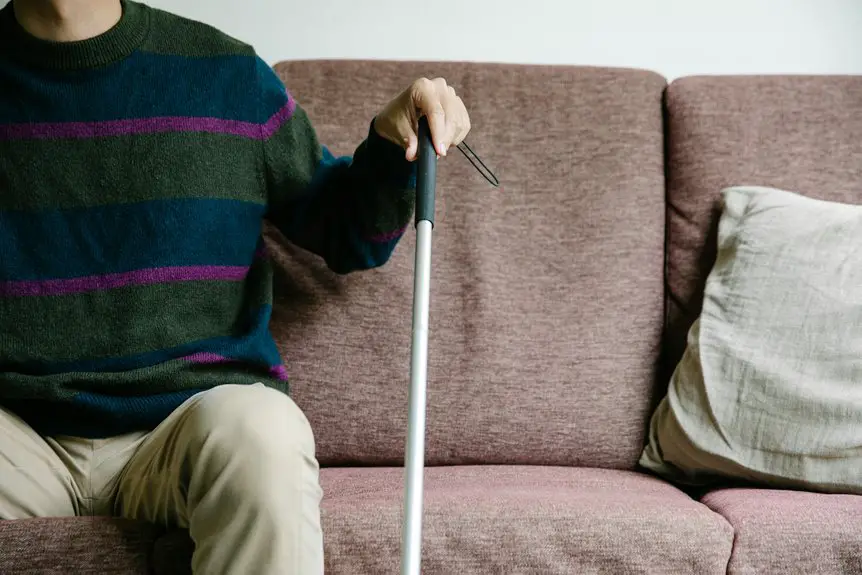To fix fabric bleeding, start by soaking the stained area in cold water with a gentle detergent for 30 minutes. Blot the fabric with a clean cloth to lift excess dye, then rinse thoroughly. If bleeding persists, repeat the soaking and rinsing process. Avoid bleach and harsh chemicals that can damage fibers. After treatment, air dry fabrics and check for any further color issues. There’s more to learn about preventing future problems and maintaining your garments beautifully.
Table of Contents
Key Takeaways
- Soak the stained area in cold water with gentle detergent for 30 minutes to lift excess dye.
- Blot the fabric gently with a clean cloth, then rinse thoroughly under cold water.
- Repeat soaking and rinsing if bleeding persists for better results.
- Avoid bleach and harsh chemicals to prevent further damage to the fabric.
- Test any new cleaning solutions on a small area before full application to ensure safety.
Understanding Fabric Bleeding
When you wash colored fabrics, you might notice that some colors bleed into others, which can ruin your clothes.
Fabric bleeding occurs when dye releases from one garment and transfers to another during washing. This often happens with vibrant or dark colors, especially if the fabric hasn’t been pre-treated or isn’t colorfast.
Factors like water temperature, detergent, and washing method can exacerbate the issue. Using hot water can cause dyes to loosen, while certain detergents can strip colors more aggressively.
To prevent bleeding, always read care labels and wash new clothes separately. If you notice bleeding, act quickly to minimize damage and protect your other garments.
Understanding these factors can help you maintain the vibrancy of your wardrobe.
Identifying Bleeding Fabrics
How can you tell if a fabric is prone to bleeding? Identifying bleeding fabrics is essential to avoid future mishaps. Here are some signs to look for:
- Vibrant colors: Bright, saturated dyes often bleed more than muted shades.
- Natural fibers: Fabrics like cotton and wool are more likely to bleed compared to synthetics.
- Poorly set dyes: If the color seems to rub off on your hands, it’s a red flag.
- Dark colors: Deep hues, especially red or black, can cause bleeding when washed.
- Inconsistent dye patterns: Fabrics with uneven dyeing can indicate potential bleeding issues.
Pre-Wash Techniques for Prevention
Before you start washing your new fabrics, it’s smart to test for colorfastness.
Try color testing swatches and pre-washing your materials to see how they react.
You might even want to soak them in salt water to help lock in those colors.
Color Testing Swatches
One simple way to prevent fabric bleeding is by color testing swatches. By doing this, you can identify any potential issues before washing your fabrics together.
Here’s how to effectively test for colorfastness:
- Choose a small fabric swatch from your new material.
- Dampen the swatch with water or a mild detergent.
- Press it against a white cloth to see if any dye transfers.
- Wait for a few minutes to check for color bleeding.
- Evaluate the results: If the white cloth remains clean, you’re good to go!
This simple test can save you from unexpected surprises in the laundry, ensuring your fabrics stay vibrant and intact.
Always take a few minutes to check before mixing different materials!
Pre-Washing Fabrics
To prevent fabric bleeding effectively, pre-washing your fabrics is an essential step that many overlook.
Start by checking the care label for washing instructions. Use cold water and a gentle detergent to avoid setting any loose dyes. If you’re working with vibrant colors, consider washing them separately to minimize the risk of color transfer.
Make sure to wash in a gentle cycle to protect the fibers and maintain the fabric’s integrity. After washing, let your fabrics air dry to prevent any potential heat damage that could cause dyes to bleed.
Salt Water Soak
A salt water soak can be a game-changer in preventing fabric bleeding. By using this technique, you can help set the dyes in your fabrics, making them less likely to run during washing.
Here’s how to do it effectively:
- Fill a large basin or tub with cold water.
- Add 1 cup of salt for every gallon of water.
- Submerge your fabric completely, ensuring it’s fully saturated.
- Let it soak for at least 30 minutes, or up to a few hours for deeper colors.
- Rinse thoroughly with cold water before washing as usual.
This simple step not only protects your clothes but also prolongs their vibrant appearance, helping you save time and money in the long run.
Effective Products for Dye Stabilization
When it comes to preventing fabric bleeding, using the right products can make a significant difference.
Recommended dye stabilizers and color-catching sheets are effective tools that help maintain the vibrancy of your fabrics.
Let’s explore how these products can protect your laundry from unwanted color transfer.
Recommended Dye Stabilizers
While fabric dyeing can produce vibrant colors, it often leads to unwanted bleeding if not properly stabilized.
To help you achieve lasting results, consider using the following recommended dye stabilizers:
- Retayne: A popular choice that helps set the dye in cotton and blends.
- Synthrapol: Great for cleaning excess dye from fabrics before washing.
- Dharma Trading Co. Color Fixative: Works well on a variety of fabrics, enhancing color intensity.
- Salt: A natural option that can help stabilize dyes in certain fabrics.
- Vinegar: Effective for setting dyes in cotton and helps reduce bleeding.
Using Color Catching Sheets
Color catching sheets are a practical solution for preventing dye bleeding during laundry. When you toss these sheets in with your colored fabrics, they absorb any loose dyes released in the wash. This helps keep your clothes looking vibrant and prevents color transfer.
To use them effectively, simply add one or two sheets to your load, depending on the size. Make sure to wash in cold water, as it helps reduce dye release. After washing, check the sheets for any color absorbed—this indicates they’ve done their job.
If you notice heavy bleeding, consider using multiple sheets next time. Incorporating color catching sheets into your laundry routine can save your favorite garments from unsightly dye stains.
Steps to Fix Existing Bleeding
Fabric bleeding can be frustrating, but fixing it doesn’t have to be a hassle. Follow these simple steps to restore your fabric:
- Act quickly: Treat the bleeding as soon as you notice it to prevent further damage.
- Soak the item: Use cold water and a gentle detergent to soak the affected area for about 30 minutes.
- Blot, don’t rub: Gently blot the fabric with a clean cloth to lift the excess dye without spreading it.
- Rinse thoroughly: Rinse the item under cold water to remove any remaining dye and detergent.
- Repeat if necessary: If the bleeding persists, repeat the soaking and rinsing process until the fabric returns to its original color.
With these steps, you’ll have your favorite garments looking good as new!
Laundry Practices to Avoid Future Issues
To prevent future fabric bleeding, it’s vital to adopt careful laundry practices.
First, always separate your laundry by color. Wash darks, lights, and whites separately to minimize color transfer.
Use cold water whenever possible, as it helps preserve fabric dyes and reduces bleeding.
When choosing detergent, opt for color-safe formulas designed to protect against fading and bleeding.
Avoid overloading your washing machine; this allows clothes to move freely and reduces friction that can lead to dye transfer.
Additionally, check wash labels for any specific instructions, and consider using a color catcher sheet for added protection.
Finally, if you’re unsure about a new garment, wash it separately for the first few washes to make certain it won’t bleed onto your other clothes.
Post-Treatment Maintenance Tips
Once you’ve treated your clothes for bleeding, maintaining their color integrity is essential.
To keep your fabrics looking fresh and vibrant, follow these simple post-treatment maintenance tips:
To maintain your fabrics’ vibrancy, follow these easy post-treatment care tips.
- Wash your clothes in cold water to prevent further fading.
- Separate colors and whites to avoid cross-contamination.
- Use a gentle detergent specifically designed for colored fabrics.
- Avoid using bleach or harsh chemicals that can strip color.
- Hang dry or use a low-heat setting in the dryer to minimize heat damage.
Frequently Asked Questions
Can Fabric Bleeding Be Permanent?
Oh, sure! Fabric bleeding’s like a stubborn guest who just won’t leave. If you don’t act fast, it can become permanent. But don’t worry, with the right steps, you can still kick it out!
How Can I Test Fabrics for Bleeding Before Sewing?
You can test fabrics for bleeding by dampening a small area with water and pressing a white cloth against it. If color transfers, it’s likely to bleed. Always prewash or use color catchers before sewing.
Is It Safe to Bleach Bleeding Fabrics?
It’s generally not safe to bleach bleeding fabrics. Bleach can intensify the bleeding or damage the fabric. Instead, try color-safe alternatives or pre-testing on a small area to see how the fabric reacts.
What Fabrics Are Least Likely to Bleed?
When choosing fabrics, opt for polyester, nylon, or tightly woven cotton. These materials typically resist bleeding due to their dyeing processes. Always check care labels to verify you’re selecting items with low bleeding potential.
Can I Prevent Bleeding With Fabric Softeners?
Imagine you’re in a vintage laundromat, surrounded by colorful fabrics. While fabric softeners can help reduce bleeding, they aren’t a guarantee. Always test first to verify your vibrant colors stay intact and don’t run together.
- Jaclyn Smith Fabric Coconut: a Review of This Rayon/Polyester Blend - June 29, 2025
- Jaclyn Smith Fabric Coconut: a Review of This Rayon/Polyester Blend - June 29, 2025
- How to Get Coconut Oil off Fabric Without Washing - June 29, 2025







